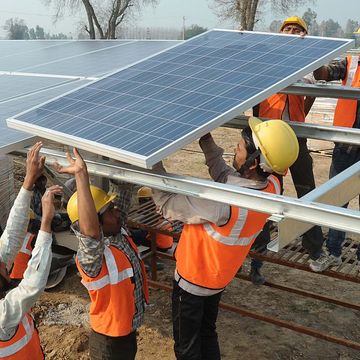- While the world does have enough lithium to power the electric vehicle revolution, it’s less a question of quantity, and more a question of accessibility.
- Earth has approximately 88 million tonnes of lithium, but only one-quarter is economically viable to mine as reserves.
- The average lithium mine takes at least a few years to get up and running, which presents problems.
Lithium is a chemical element and key component of electric vehicle (EV) batteries that’s also known by another name: “white gold.” That’s because in a future powered by batteries, from our electric cars to our smartphones, lithium is quickly becoming the most valuable commodity on the planet.
But unlike the sun, which sends down its energy in limitless abundance through its rays, lithium is a finite material. Once it’s gone, it’s gone.
When talking about our desperate need for a green-energy future, there’s been a lot of hand-wringing over whether there’s enough lithium locked away inside igneous rock and saltwater brine to meet the demand of an increasingly electrified world. Recently, Hannah Ritchie, a data scientist at Oxford University, examined whether this lithium scarcity could actually impact the world’s future green energy plans.
In short, Earth is more than capable of supplying all the lithium we need for the foreseeable future. Getting it out of the Earth, on the other hand, is a whole different story.
According to the U.S. Geological Survey (USGS), Earth plays host to some 88 million tonnes of lithium. Of that number, only one-quarter is economically viable to mine (this is known as “reserves”). Luckily, Earth’s total reserves of lithium will likely increase as technology improves. For example, the USGS estimated only 13 million tonnes of lithium on Earth just a decade ago.
Nature reports that your average car likely takes up about 8 kilograms of lithium (another number that’ll likely decrease over time). After some number crunching, courtesy of Ritchie, you get 2.8 billion EVs from that 22 million tonnes of lithium. With 1.4 billion cars on the road now, that might seem like a tight margin, but one likely improved with growing innovations in mining and battery technology—not to mention this is only Earth’s reserves of lithium. When extrapolated out to 88 million tonnes, that adds up to around 11 billion EVs.
The biggest challenge where some of that hand-wringing is justified is in answering how we’re going to extract the necessary amount of lithium in the first place.
Ritchie’s estimations, based on data from the International Energy Agency (IEA), show that an electrified economy in 2030 will likely need anywhere from 250,000 to 450,000 tonnes of lithium. In 2022, the world produced only 113,000 tonnes. With the average lithium mine taking at least a few years to get up and running, we need to figure out how to get at this lithium quick.
This brings us to maybe the greatest challenge of the EV revolution: how to quickly mine lithium (to start the green tech revolution our planet desperately needs) while not leaving behind a litany of ecological disasters and human rights abuses in our wake.
Lithium mines use a lot of water—many thousands of gallons per minute, according to The New York Times—and groundwater contamination with antimony and arsenic are a real and persistent threat. Other side effects of lithium mines include biodiversity loss, soil erosion, and air quality degradation—and that doesn’t even include what moving mining operations to the ocean floor could do.
Innovation can offer hope. One mining operation in Manitoba, Canada, is working to be a renewable and sustainable lithium mining operation with nearly all of its power drawn from hydroelectric energy, while also banning diesel-burning trucks and equipment. Increased efficiency in lithium recycling could also be a major boon to making these reserves last longer.
If more mining operations follow suit, we can hope to have an electrified future worth saving.
Darren lives in Portland, has a cat, and writes/edits about sci-fi and how our world works. You can find his previous stuff at Gizmodo and Paste if you look hard enough.













